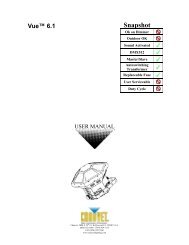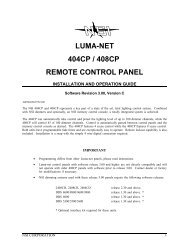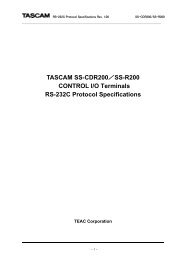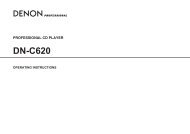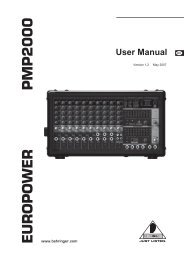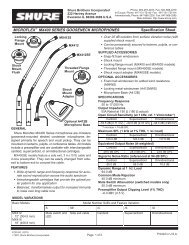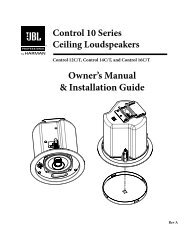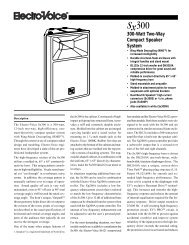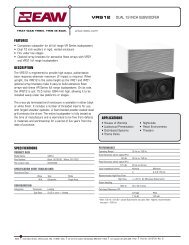PDF Manual of the TC Electronic VoiceWorks Plus - Direct Pro Audio
PDF Manual of the TC Electronic VoiceWorks Plus - Direct Pro Audio
PDF Manual of the TC Electronic VoiceWorks Plus - Direct Pro Audio
You also want an ePaper? Increase the reach of your titles
YUMPU automatically turns print PDFs into web optimized ePapers that Google loves.
REVERB, μMOD AND DELAY EDITINGset up to 1800ms (1.8 seconds) <strong>of</strong> delay for <strong>the</strong> left andright delay lines here.Tempo: This setting is shown when Tap or MIDI isselected for <strong>the</strong> Src parameter.There is one setting fortempo in beats per minute (bpm) that is used to derivedelay times for both <strong>the</strong> left and right delay lines thatis <strong>the</strong>n subdivided by <strong>the</strong> division set in <strong>the</strong> nextscreen.L - Beat Div - R: (Left and right beat division) When <strong>the</strong>Src is set to Tap or MIDI, turning <strong>the</strong> Data wheel willreveal this screen allowing you to divide <strong>the</strong> delaytempo into even or synchopated beats.D2: Delay feedback and cross feedback amountsFBL, FBR: (Feedback left and right) Re-introduces aportion <strong>of</strong> <strong>the</strong> audio output signal <strong>of</strong> <strong>the</strong> Delay blockback to <strong>the</strong> input to add repeats.XFL, XFR: (Cross feedback left and right) Crossfeedback returns <strong>the</strong> delayed audio to <strong>the</strong> oppositeside’s delay line for ping pong type effects.D3: Low band filteringLowCutL, LowCutR: (Low cut left and right) Removeslow frequencies from <strong>the</strong> audio delays to constrain<strong>the</strong>m to a specific band.D4: High band filteringHiCutL, HiCutR: (High cut left and right) Removes highfrequencies from <strong>the</strong> audio delays to constrain <strong>the</strong>m toa specific band.R0: Reverb Style (Reverb style selection)Use <strong>the</strong> s<strong>of</strong>t knob assigned to this parameter tochoose a reverb style you like.R1: Decay time and predelay settingsDecayTime: (Decay Time) Sets <strong>the</strong> length <strong>of</strong> <strong>the</strong> reverbtail.PreDly: (Predelay) Introduces a short delay between<strong>the</strong> dry audio signal and <strong>the</strong> onset <strong>of</strong> reverb to simulatelarger spaces and to improve <strong>the</strong> audio separationbetween <strong>the</strong> dry signal and <strong>the</strong> reverb effect.R2: Reverb tail filteringLowColor, HiColor:These are preset filters that tailor<strong>the</strong> low and high frequency response <strong>of</strong> <strong>the</strong> reverbtails.R3: Room and tail level balanceRoomLev: (Room level) Each reverb style has a preconfiguredshort initial reflection sound that can beboosted or attenuated with this control.TailLev: (Tail level) The “tail” is <strong>the</strong> long, decayingcomponent <strong>of</strong> reverb.You can adjust <strong>the</strong> mix between<strong>the</strong> tail and <strong>the</strong> room with this control.Reverb block editing menus R0-R3Reverb is <strong>the</strong> arguably <strong>the</strong> most common vocal effect .It can add a spaciousness that s<strong>of</strong>tens <strong>the</strong> abruptbeginnings and endings <strong>of</strong> lyric phrases. Many reverbtypes are meant to imitate <strong>the</strong> natural sound <strong>of</strong> spaceslike churches, clubs and halls but not all. Some reverbeffects are recreations <strong>of</strong> electro-mechanical effectsmeant to imitate real spaces like plates and springs.Allreverbs are made up <strong>of</strong> early reflections (rooms), and<strong>the</strong> longer reverberant sounds (tails). Commoncontrols are <strong>the</strong> level <strong>of</strong> <strong>the</strong> room (Room Level), and<strong>the</strong> level and decay <strong>of</strong> <strong>the</strong> tail (Tail Level, ReverbDecay). Additionally, a small delay can be addedbetween <strong>the</strong> dry voice and <strong>the</strong> reverb signal (Predelay)that adds clarity. By far <strong>the</strong> most important control forreverb is <strong>the</strong> level. One reverb patch can have a verydifferent result for <strong>the</strong> audience whe<strong>the</strong>r it is mixedsubtly, or up front in <strong>the</strong> mix.35




